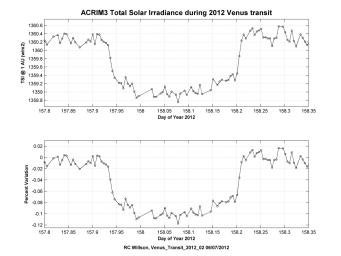
|
NASA’s ACRIMSAT Observes Venus Transit
- Click the image above for a larger view
- Full-Res JPEG (4800 x 3600) (993.2 kB)
- Full-Res TIFF (4800 x 3600) (17.3 MB)
Caption:
Observations of the total solar irradiance made with the ACRIM3 instrument on NASA's ACRIMSAT satellite on June 5 and 6, 2012, tracked the effect of the transit of Venus, which lasted about six hours.
Venus' angular diameter in transit is approximately one-thirtieth the diameter of the sun, so it covered approximately 0.1 percent of the sun's surface. The ACRIM 3 data measure changes in total solar irradiance over time with a sample certainty of approximately 0.007 percent. ACRIM3 observed a maximum decrease in total solar irradiance of approximately 1.4 watts per square meter, or approximately 0.1 percent, which closely corresponds to the apparent size of Venus compared to that of the sun as seen from Earth.
Analyses of the radiation from the edge of the sun as Venus transited shows features characteristic of Venus' atmosphere. This information can provide a model to look for the signature of planetary atmospheres when similar observations are obtained from the transits of planets in orbit around other stars (known as exoplanets).
The ACRIMSAT/ACRIM3 experiment has been monitoring variations in total solar irradiance for NASA since 2000 and made nearly full-time observations during the 2012 transit of Venus. The ACRIMSAT project manager, Sandy Kwan, of NASA's Jet Propulsion Laboratory, Pasadena, Calif., made a special effort to acquire ACRIM3 total solar irradiance data in near real time and provide them to the Principal Investigator of the ACRIM3 Science Team, Dr. Richard C. Willson, for prompt processing and production of total solar irradiance results.
Cataloging Keywords:
| Name | Value | Additional Values |
|---|---|---|
| Target | Venus | Sun |
| System | ||
| Target Type | Planet | Sun |
| Mission | Active Cavity Irradiance Monitor Satellite (AcrimSat) | |
| Instrument Host | Active Cavity Irradiance Monitor Satellite (AcrimSat) | |
| Host Type | ||
| Instrument | Active Cavity Irradiance Monitor 3 (ACRIM 3) | |
| Detector | ||
| Extra Keywords | Atmosphere, Grayscale, Orbit | |
| Acquisition Date | ||
| Release Date | 2012-06-15 | |
| Date in Caption | ||
| Image Credit | NASA/JPL-Caltech | |
| Source | photojournal.jpl.nasa.gov/catalog/PIA15820 | |
| Identifier | PIA15820 | |
